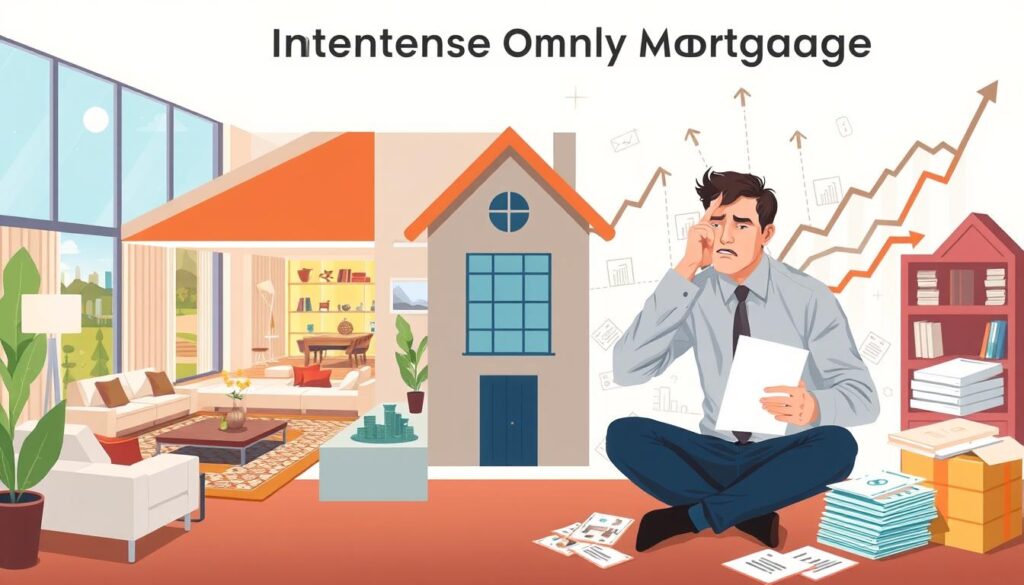As we navigate the realm of home financing, the interest-only mortgage often surfaces as a considerable option, particularly for those seeking low payment mortgage solutions. At its core, an interest-only mortgage facilitates lower monthly outlays initially, as borrowers remit payments solely towards the loan interest. This type of financing arrangement tends to offer breathing room for homeowners, especially in the early stages of homeownership. However, delving deeper into the pros and cons interest-only mortgage terms reveal, one must acknowledge the shift in payment structure that occurs once the typically 5 to 10-year interest-only period lapses. Subsequently, mortgage payments increase to encompass both principal and interest, potentially introducing a steep adjustment for the unwary borrower.
Distinctly characterized by fluctuating payments, interest-only mortgages often bear adjustable rates. This variability can influence the long-term feasibility of retaining a property, especially for those not prepared for rate hikes. Nevertheless, the initial lower payments can attract certain profiles of homebuyers, notably investors in rental properties, or those with non-traditional income sources anticipating eventual income augmentation. Conversely, mainstream buyers generally find refuge in the stable territory of conventional mortgages offered by institutions such as Discover Bank, who stand clear of interest-only loan products.
Moreover, an important financial aspect to consider is the tax implications of interest-only loans, where the IRS permits the deduction of interest payments up to a substantial home value threshold. And while the temptation to indulge in a more expensive home purchase is moderated by the facility to make extra principal payments, one cannot ignore the looming potential of cost increase over time and, more detrimentally, the absence of equity build-up during the interest-centric phase of the loan.
The resurgence in popularity of interest-only mortgages underscores the contemporary homebuyer’s propensity to exploit short-term financial reprieve. However, the current economic climate exhibits a contraction in lender enthusiasm towards such high-risk loan offerings. Thus, those considering this route must perform rigorous financial assessments to ensure the sustainability of the inevitable transition to full mortgage repayments.
Key Takeaways
- Interest-only mortgages provide low initial payments, benefiting those with specific financial strategies.
- After the interest-only term, increased payments can pose significant challenges to homeowners.
- These loans may be accompanied by adjustable rates, introducing uncertainty into long-term planning.
- Tax benefits for interest paid on such loans may provide financial relief for eligible homeowners.
- Always assess the long-term financial outcome, considering the higher overall cost against conventional loan alternatives.
- Being strategic about additional principal payments can aid in mitigating the risks associated with a lack of equity growth.
- Homebuyers need to appraise their financial stability and the practicality of refinancing before securing an interest-only mortgage.
Understanding Interest-Only Mortgages
Interest-only mortgages differ noticeably from more traditional home loans primarily because they allow payment of only the interest amount during a preliminary phase. Typically lasting from 5 to 10 years, these interest-only mortgage terms give a significant temporary relief in monthly payments. However, these loans convert to paying off the principal, usually on an adjustable rate that can fluctuate and increase the financial burden.
Interest-only mortgages are often structured as adjustable-rate mortgages (ARMs), which may start with lower interest rates than the standard fixed-rate mortgages but are subject to change. These types of mortgages don’t build equity during the interest-only payment period unless house prices are rising. Afterward, when borrowers begin to pay down the principal, monthly payments can considerably increase.
| Loan Type | Interest Rate | Initial Monthly Payment | Period |
|---|---|---|---|
| 7-year interest-only ARM | 3.125% | $260.42 | Introductory |
| 30-year fixed-rate conventional | 3.625% | $456.05 | Full term |
| 7-year fully amortizing ARM | 2.875% | $414.89 | 30 years |
It’s crucial for prospective borrowers to understand the specifics of an interest-only mortgage. Rates on these mortgages are approximately 0.125% to 0.375% higher than those for amortizing loans. Yet, the allure of significantly lower payments during the interest-only period can be appealing, particularly for those aiming to maximize short-term cash flow or invest the savings in higher return opportunities.
Statistics indicate that interest-only loans were famously popular in the early 2000s but have since become rare post-Great Recession. Today, they require a stringent qualification process including a good credit score (typically 700 or above), a low debt-to-income ratio (43% or less), and a significant down payment (usually 20%). This stringent pre-qualification ensures that these risk-laden loans are offered to financially stable individuals capable of managing potentially higher future payments.
Given the nature of interest-only mortgages, borrowers must have a solid plan to manage the payment increases once the initial period ends. Strategic financial planning and readiness for rate adjustments are pivotal to avoid financial strain or potential default.
}
How Interest-Only Mortgage Payments Work
Understanding the dynamics of interest-only mortgage terms is crucial for potential homeowners, particularly when eyeing a low payment mortgage setup initially. These mortgage options allow borrowers to pay only the interest on the loan for a set period, typically 5 to 10 years, before the payment structure shifts to include both principal and interest. This period can notably reduce the monthly financial burden on the homeowner during the early years of homeownership.
The initial interest-only period is appealing for various reasons, chiefly due to its provision of lower monthly outgoings, enabling homeowners to allocate funds towards renovations, furniture, or even personal investments. However, it’s essential to recognize that the interest-only mortgage often involves adjustable rates, which can result in higher payments once the initial period expires.
| Mortgage Type | Initial Payment Structure | Post-Initial Payment Changes |
|---|---|---|
| Fixed-rate Interest-Only Mortgage | Fixed interest for 5-10 years | Shifts to higher interest and principal payments |
| Adjustable-rate Interest-Only Mortgage | Variable interest for 5-10 years | Possible significant increase in payments |
For those considering this form of financing, it’s important to strategize for the long term. After the interest-only period, if not managed wisely, the sudden increase in monthly payments can strain one’s finances, especially if the adjustable rates climb. Therefore, potential borrowers should ensure they are prepared for possible fluctuations in interest rates and, consequently, their monthly dues.
Ensuring a stable and secure financial avenue to cover the impending increase in payments is crucial for anyone exploring interest-only mortgage terms. Planning, understanding market trends, and financial counseling might be necessary steps to mitigate the risks associated with these mortgage structures.
Why Some Homebuyers Choose an Interest-Only Mortgage
Exploring the reasons behind opting for an interest-only loan reveals a combination of strategic financial planning and significant immediate financial benefits. Homebuyers are often attracted to the benefits of interest-only mortgages, primarily when used as a short-term strategy. Here, we delve into why these loan structures are appealing.
Lower Initial Monthly Payments
One of the most compelling features of an interest-only mortgage is the low payment mortgage aspect during the initial phase. This phase, typically lasting from 5 to 10 years, requires borrowers to pay only the interest on the loan, thereby significantly reducing their monthly outlay. These lower payments enable homeowners to manage other financial obligations more comfortably or invest in higher-return opportunities.
Greater Cash Flow Flexibility
The reduced monthly payment during the interest-only period offers significant cash flow flexibility. This aspect of interest-only loans is exceptionally beneficial for professionals anticipating a rise in income, allowing them to channel current financial resources into other areas such as business ventures, investments, or higher-return assets, without compromising their living standards.
Affordability of a More Expensive Home
By opting for an interest-only mortgage, borrowers can afford a more expensive home than they might with a traditional loan. The initial lower payment enables buyers to enter higher-priced housing markets, providing an opportunity to acquire a more valuable property as a potential long-term investment, especially in rising real estate markets.
| Interest-Only Mortgage Feature | Benefit |
|---|---|
| Reduced Initial Monthly Payments | Allows increased cash flow for other investments or expenses |
| Flexibility During Interest-Only Period | Financial adaptability for anticipated future income increase |
| Affordability of More Expensive Homes | Access to higher-value properties in competitive markets |
The Impact of Interest-Only Loans on Housing Affordability
When considering housing affordability, the interest-only mortgage stands out as an attractive option due to its initially low payment mortgage structure.
Assessing the Overall Cost
The allure of an interest-only mortgage often lies in the significantly reduced monthly outlay during the early stage of the mortgage term. Typically, these terms extend between 5 and 7 years, enabling borrowers to manage their finances more flexibly during this period. This can be particularly beneficial for those with variable income streams or entrepreneurs who anticipate higher earnings in the future.
Comparing Long-Term Financial Impact
However, it’s crucial to juxtapose these initial benefits with the long-term financial implications of choosing an interest-only mortgage. After the interest-only period concludes, borrowers face increased payments as they begin to pay down both principal and interest. This adjustment can lead to payment shock, especially if mortgage rates rise.
Given these dynamics, we provide a comparative analysis to illustrate the potential outcomes of choosing an interest-only mortgage over a traditional repayment mortgage.
| Mortgage Type | Monthly Payment | Total Interest Paid | Total Amount Repaid |
|---|---|---|---|
| Interest-Only Mortgage | $1,042 | $375,271 | $625,271 |
| Repayment Mortgage | $1,343 | $233,340 | $483,340 |
The table underscores the stark difference in total payments made over the course of a mortgage. While the low payment mortgage of the interest-only option may seem appealing, it is essential for borrowers to consider the long-term costs that accrue, emphasizing the importance of planning and understanding personal financial trajectories.
Interest-Only Mortgage
Opting for an interest-only mortgage means making payments that cover only the interest on the loan amount for an initial set period, traditionally three to ten years. Here, the principal remains untouched, leading to notably lower monthly payments initially. However, such low payment mortgage terms adjust significantly once this phase ends, requiring payments towards both principal and interest.
An interest-only mortgage can be an enticing option for certain borrowers due to the interest-only mortgage terms that make costly homes more accessible in the short term. Yet, the shift to a full repayment schedule can be a stark financial change. This is especially pertinent as most interest-only loans are coupled with adjustable-rate mortgages (ARMs), meaning the interest rates might increase over the loan term.
Understanding the specifics of these products and their qualifications is crucial. For instance, requirements often necessitate at least a 680 credit score and a lower debt-to-income ratio compared to standard loans. Additionally, higher down payments are typical to secure this type of financing.
| Aspect | Detail |
|---|---|
| Interest-only period | 3-10 years |
| Typical credit score requirement | 680 or higher |
| Potential loan structure | Adjustable-rate |
| Post interest-only period | Payments increase to cover principal and interest |
| Primary benefit | Lower initial payments, allowing access to more expensive properties |
| Main risk | Significant payment increase post-interest-only period |
By making well-informed decisions and preparing for future financial adjustments, borrowers can manage an interest-only mortgage effectively, despite its potential risks. This strategic approach is vital for leveraging the benefits of such unique and flexible mortgage solutions.
Advantages of an Interest-Only Mortgage
Understanding the benefits of interest-only mortgage terms can significantly impact one’s financial planning and investment strategies. These mortgages provide specific financial flexibilities that are not typically observed with traditional mortgage products. Let’s delve into how these advantages can serve particular financial situations effectively.
Potential for Increased Savings
One of the notable benefits of using an interest-only mortgage is the potential for increased savings during the initial interest-only period. Since you’re required to pay only the interest without touching the principal amount, the monthly payments are considerably lower compared to conventional mortgages that include principal repayment.
This arrangement provides an excellent opportunity for homeowners to manage their cash flow better. The money saved each month can be redirected towards other vital financial goals, like retirement savings, investing in stocks, or clearing high-interest debts, which might ultimately offer a higher return.
Flexibility for Strategic Financial Planning
The flexibility offered by interest-only mortgage terms cannot be understated. For those anticipating a significant increase in income in the future, this type of mortgage allows for smaller payments now, setting the stage for larger payments later. This can be particularly advantageous for professionals in fields with progressive pay scales or entrepreneurs who expect their businesses to grow.
Additionally, this financial flexibility facilitates strategic asset management, particularly in a rising property market. Homeowners might choose to sell their property for a profit before transitioning into higher repayments or converting their mortgage type once the interest-only period concludes.
Moreover, the use of an interest-only mortgage can serve as a cushion during times of financial unpredictability. In scenarios where maintaining liquidity is crucial, having the option to pay only the interest can safeguard against potential financial strains.
In conclusion, while exploring the benefits of interest-only mortgage terms, prospective borrowers should thoroughly assess their long-term financial stability and goals. With prudent planning and strategic use of the funds otherwise spent on principal repayment, an interest-only mortgage can offer substantial financial benefits and flexibility.
Risks Involved with Interest-Only Mortgage Terms
Exploring the pros and cons interest-only mortgage can provide, it’s crucial to understand the significant risks of an interest-only loan, particularly the financial implications and potential for instability they bring forth. Interest-only mortgages, while offering lower initial payments, possess unique challenges that might affect borrowers’ long-term financial health.
Lack of Equity Build-Up
One of the primary concerns with interest-only loans is the slow pace at which borrowers build equity in their homes. During the interest-only period, payments made are applied only to the interest, not reducing the principal balance of the loan. This situation can prolong a state of minimal home equity unless market values increase. Statistically, interest-only mortgages are not as widely adopted, highlighting the caution that potential homeowners maintain towards this financing option.
Variable Interest Rates and Payment Shock
Moreover, the structure of interest-only mortgages often includes variable interest rates, which introduces another layer of uncertainty. Following the initial period where interest forms the bulk of the payment, rates can increase based on market conditions. This adjustment can lead to payment shock, where monthly obligations suddenly increase, potentially doubling or tripling the initial amounts. These unexpected spikes in required payments can strain personal finances and lead to severe financial consequences.

| Year | Interest-Only Mortgages Maturing | Location with Highest Prevalence |
|---|---|---|
| 2027 | Small peak | London (21%) |
| 2031 | 72,000 | South West (13%) |
| 2032 | 77,000 | South East (12%) |
With such risks at stake, potential borrowers should weigh the pros and cons of an interest-only mortgage thoroughly. An informed decision entails understanding not only the flexibility these loans offer during the initial period but also the potential implications during rate adjustments and the longer-term horizon.
Using an Interest-Only Mortgage Calculator to Estimate Payments
When considering an interest-only mortgage, a vital tool in your toolkit should be an interest-only mortgage calculator. This calculator is essential for anyone looking to understand how their payments will change over time, especially transitioning from interest-only payments to the combined principal and interest payments.
Interest-only mortgages can be attractive due to their initially lower payments, which do not include principal repayment. These types of loans typically offer a period—often 5 to 10 years—during which you pay only the interest on the loan. Once this period expires, you begin to pay back both the principal and the interest, which can significantly increase monthly payments.
Using an interest-only mortgage calculator not only helps you visualize your payments during the interest-only period but also frames a clear picture of future financial obligations once this period ends. It’s this transition that often surprises borrowers, potentially leading to what is known as payment shock.
In addition to estimating monthly payments, understanding the interest-only mortgage terms is crucial. These terms can impact the total amount paid over the life of the loan, as interest-only loans might have higher interest rates compared to traditional mortgages. This can result in higher overall costs over the duration of the loan.
- Visualize initial lower payments during the interest-only period.
- Prepare for the shift to higher payments once principal repayment begins.
- Assess total costs over the loan’s lifetime considering potentially higher interest rates.
Using these calculators, you can input various scenarios to see how different terms and rates affect your payments. This proactive approach is not just about managing expectations but planning your financial future effectively.
It’s essential for prospective borrowers to be aware that interest-only mortgages, while offering lower initial payments, may not be as straightforward as they appear. They often require borrowers to meet more stringent qualification criteria due to their non-conforming loan status. Furthermore, after the interest-only term ends, the increased payments can strain your finances if not planned for meticulously.
Therefore, it is advisable to use an interest-only mortgage calculator as part of a broader strategy for financial management when considering these types of mortgage options. By fully understanding the interest-only mortgage terms, you can make more informed decisions that align with your long-term financial goals.
Qualifying for an Interest-Only Mortgage
Securing a qualifying interest-only mortgage isn’t as straightforward as one might hope. It requires careful consideration of numerous financial factors to ensure the borrower can meet future payment obligations. Let’s delve deeper into what it takes to qualify for this form of low payment mortgage and the financial implications it holds.
Credit Score and Debt-to-Income Considerations
A credit score of 700 or higher is typically required for an interest-only mortgage. Lenders scrutinize debt-to-income ratios, ideally looking for a ratio of 43% or less. This stringent credit evaluation ensures that borrowers are not only creditworthy but also likely to handle higher payments that emerge after the interest-only period.
Financial Stability and Down Payment
To minimize risks, lenders assess financial stability, requiring substantial down payments—often 20% or more. Additionally, showing proof of future earnings and having substantial assets can further reassure lenders of a borrower’s preparedness for an interest-only mortgage.
Understanding Loan Dynamics
Interest-only mortgages can initially present a low payment mortgage opportunity, stretching over a typical period of 7 to 10 years within a 30-year term. Post the interest-only period, the payments adjust to include both principal and interest, necessitating a thorough initial financial assessment.
| Parameter | Interest-Only Mortgage | Traditional Mortgage |
|---|---|---|
| Credit Score Requirement | ≥ 700 | ≥ 650 |
| Down Payment | ≥ 20% | ≥ 10% |
| Debt-to-Income Ratio | ≤ 43% | ≤ 50% |
| Payment Post-Interest-Only Period | $2,033 (estimate) | $1,882 (fixed) |
| Total Paid over Loan Term | $677,000 | $677,000 |
Engaging with experienced lenders like Carlyle Financial can simplify navigating these complex scenarios, ensuring borrowers are matched with the right financial products according to their individual needs.
Conclusion
As we have journeyed through the details regarding interest-only mortgages, it has become clear that understanding both the pros and cons of interest-only mortgages is crucial for anyone considering this financing option. Let’s consider some key takeaways from our discussion to better grasp the practical applications and implications of choosing such a loan structure.

In weighing the pros and cons of interest-only mortgages, it is evident that these loans offer specific benefits, like lower monthly payments and increased cash flow, leading to improved financial flexibility. These advantages may suit borrowers such as high-income earners or those with irregular income streams, like freelancers or entrepreneurs.
Yet, it’s imperative to acknowledge the potential drawbacks. The possibility of payment shock and the absence of equity build-up during the interest-only period are significant risks. Such factors could jeopardize financial stability if not managed with foresight and careful planning.
| Benefit | Risk |
|---|---|
| Lower initial monthly payments | Payment shock after interest-only period |
| Enhanced cash flow | Slower equity build-up |
| Opportunity for higher investment returns | Higher total interest costs over the loan’s lifespan |
| Flexibility in managing finances | Risk of negative amortization |
In conclusion, whether an interest-only mortgage is the right choice largely depends on one’s financial circumstances, future income expectations, and personal financial management skills. Consulting with mortgage professionals can provide personalized insights and guidance, tailor-suited to one’s financial health and long-term objectives. Understanding every facet of the interest-only mortgage is key to making an informed decision that aligns with personal and financial goals.
Essential Tips for Potential Interest-Only Mortgage Borrowers
For those considering an interest-only mortgage, skillful anticipation and preparation are vital to harness its benefits while mitigating risks. Understanding that interest-only mortgages have an initial phase of 5 to 10 years during which the borrower only pays the interest, it’s important to project one’s financial standing over this period. A real-world example illustrates, with a $300,000 loan at a 5% interest rate, the interest cost amounts to $15,000 annually during this phase. Strategic foresight in interest-only mortgage planning should include preparing for rate fluctuations and future principal payments.
Though the allure of lower initial monthly payments from an interest-only mortgage—such as the $1093 monthly payment on a $250,000 loan at a 5.25% interest rate—is strong, one must also remain cognizant of the eventual need to repay the principal. Types of interest-only mortgages, such as adjustable-rate, fixed-rate, and hybrid, offer different advantages. For instance, hybrid models start with a fixed rate, which can then move to a variable rate. While each has its merits, they require a comprehensive evaluation against one’s financial plan. In assessing interest-only mortgage tips, remember to consider factors like higher credit score requirements, more considerable down payments, and the potential for future payment increases.
Lastly, engaging with interest-only mortgage terms involves recognizing both the advantages, such as the opportunity to increase investments or savings, and the potential disadvantages, like minimal equity growth. From buy-to-let investors to high-net-worth individuals seeking flexibility, these loans can align with diverse financial goals. Case studies, such as those of business owners leveraging mortgages for business growth, highlight such strategic uses. Yet, whatever the motivating scenario, ensuring a viable exit strategy for the repayment period—be it selling the property, using accumulated assets, or refinancing—is one of the most insightful interest-only mortgage tips we can impart.







